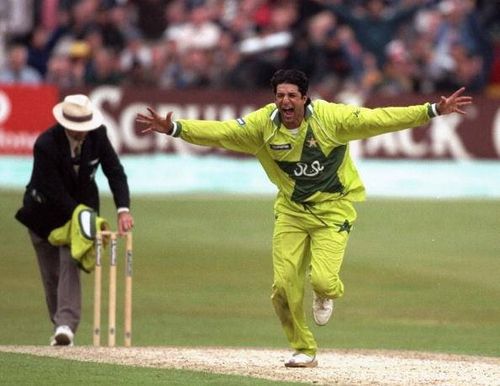
Statistical comparison: Wasim Akram vs Glenn McGrath

There is something about fast bowlers. The temper. The rapid bursts. The moving ball. The run-ups. The big leap a few meters from the popping crease. The follow-through. The occasional words spoken to the batsmen. The glares at the fielders who are sloppy. The celebrations after getting the opposition’s best batsman out. The carnival following the perfect plan justified by the perfect execution and the perfect result. There is something about them.
Like all other skills, we need to divide this lovely art into two styles – the left arm bowlers and the right arm bowlers. And then, wouldn’t it be a statistician’s dream to compare the best left arm bowler that ever held the cherry and the best right arm fast bowler who ever held it.
The game has had its fair share of romantics who gave their favourite bowlers their fair share of epithets. There was White Lightning and then there was Whispering Death; terror, Menace, Killer and plenty of other words to embellish the quality of fast bowling that these bowlers conjured, sometimes at will, sometimes inspired, sometimes motivated, sometimes demotivated.
But, from a different era that we don’t quite understand, it is not fair to pick candidates. Before the helmets, before covered pitches, before front foot no-ball rules, before the game changed into something else, transformed, morphed, evolved. Contemporary cricket could then be filtered down to two greats – the epitome of high-quality bowling – Glenn McGrath and Wasim Akram. They couldn’t be more different.
Style of bowling
Glenn McGrath, with the cherry, could’ve been a robot, programmed to run up, exactly the same way and pitch the ball exactly at the same spot. He was a hit the deck kind of bowler, who relied on nothing more than doing the mechanical things to perfection.
He made an art out of delivering the ball exactly the same way every single time for more than a decade, on varied surfaces, under different conditions and against different opponents. To McGrath, it didn’t matter who the opponent was. His game plan was to be the perfect machine, exploiting the Corridor of Uncertainty, the channel dreaded by every batsman, with the ball pitching on the spot that confused them, where they didn’t know whether to move forward or backward.
Then there was the seam position, always upright, giving the ball an opportunity to move off the deck if there was anything there. That was McGrath. He was more Curtly Ambrose, than Ambrose himself ever became and therein lies his greatness.
And then there was Wasim Akram – an anti-thesis to McGrath’s consistency. Wasim Akram was the Sultan of Swing with a short run-up, a hurried approach and a quick arm action. But, he could crank it up. Akram would move the ball either way at will. He would reverse it later. There are times when Akram would make the same delivery move twice, in the air and off the deck.
Ask Rahul Dravid, who probably faced the greatest ball delivered by a pace bowler in the era of Live Cricket. Akram was bred, unlike McGrath on the sub-continental pitches, which meant he rarely had assistance off the deck. So he had to make friends with the ball, coax it into doing things for him, like a snake-charmer coaxed his pet to dance to his tunes and enamour the audience.
Akram’s deliveries reared and moved and hissed like he were a snake-charmer. Ask the English who were an Akram short of winning the World Cup. Ask Sachin Tendulkar, who in spite of all his greatness and all his victories, has the bitter thorn of Chennai stuck in his memories.

Maybe, if we blend McGrath and Akram together, you would get the perfect killing machine, which no batsman could ever dominate, yin and yang of pace bowling.
Test Matches
Using stats to compare Wasim Akram and Glenn McGrath is like using a ruler to taste honey. It is ill-conceived. But, stats sometimes help us fathom the greatness of an art perfected by two different bowlers. Great is an oft-used word but no one defines it better than these two, through the sheer volume of what they have managed to accomplish over an extraordinarily long time.
Name
Tests
Wickets at home
Average at home
Wickets Away
Average away
Total Wickets
Average
Strike-rate
Glenn McGrath
124
289
22.43
274
20.81
563
21.64
51.9
Wasim Akram
104
154
22.22
260
24.44
414
23.62
54.6
Round 1 has to be awarded to McGrath. He obviously has a lot more wickets to show for and more Tests. But the most important numbers here are the averages. McGrath averages only marginally higher than Akram at home. It is a remarkable achievement on Akram’s behalf that he managed a better average on Pakistan’s low, often unresponsive tracks than what McGrath managed on the bouncy tracks of Australia.
The Aussie though manages excellent average away from home, which is amazing considering he bowled a lot of those overs on the flat, turning tracks of India and Sri Lanka. The defining stat overall is the strike-rate. McGrath, with a lower strike rate managed a wicket almost every 52 balls, 2.7 balls fewer than what Akram needed for every wicket of his.
Name
Wins
Wickets
Average
Strike-rate
Glenn McGrath
84
414
19.19
47.7
Wasim Akram
41
211
18.48
42.3
Round 2 clearly goes to Akram, as a bowler. McGrath, part of an invincible team for the better part of a decade, had more than twice the number of wins as Akram. Yet, Akram’s average of 18.48 is lower than that of McGrath’s. It must be noted that the Pakistani didn’t have the support of his batsmen half the time where McGrath enjoyed the services of probably the best contemporary Test batting order under all conditions.
More importantly, in wins, Akram’s strike-rate is 5.4 balls fewer, an amazing accomplishment considering how many of them came in unfavourable conditions. To conclude, Akram’s performance was a lot more critical to Pakistan’s fortunes than McGrath’s for Australia based on the stats.
One Day Internationals
Name
ODIs
Wickets
Average
Economy
4+ Wickets
Glenn McGrath
250
381
22.02
3.88
23
Wasim Akram
356
502
23.52
3.89
17
Round 3 has to go to Wasim Akram for the sheer volume of games and wickets. Neck and neck on average and economy, Akram has 121 more wickets having played 106 games more. In McGrath’s defence, he averaged 1.524 wickets per every game to Akram’s 1.41. One could walk to the end of the world and find the exercise easier than having to pick one of these two great legends for an ODI game.
Name
ODI Finals
Wickets
Average
Economy
4+ Wickets
Glenn McGrath
27
55
16.43
3.92
4
Wasim Akram
36
49
24.18
3.77
1
Round 4 definitely goes to the tall Aussie. He was the better big-match player compared to Akram. In tournament finals, McGrath averaged more than two wickets per game, whereas for Akram the number was just about 1.35. Although he had a lower economy rate, his tournament finals’ average was nearly eight points higher than that of McGrath. McGrath also managed four four-wicket hauls to Akram’s one.
Name
ODI Wins
Wickets
Average
Economy
4+ Wickets
Glenn McGrath
171
301
17.94
3.65
15
Wasim Akram
199
326
18.86
3.7
18
Round 5 is a tie. In ODI wins, Akram and McGrath were neck and neck. While Akram had more wickets owing to more wins numerically, McGrath averaged marginally better than the great man and also boasted of a slighter better economy rate.
Name
World Cup ODIs
Wickets
Average
Economy
4+ Wickets
Glenn McGrath
39
71
18.19
3.96
2
Wasim Akram
38
55
23.83
4.04
3
Round 6 is won by Glenn McGrath hands-down. This is probably the only comparison where the numerical difference of the number of games played by both bowlers vanishes leaving us with a direct comparison.
Both bowlers have won World Cups, McGrath winning three of them, in England, South Africa and in West Indies. While their economy rates are closer to each other, McGrath averages way better than Akram because of the chunk of wickets he has engulfed. It is hard to see McGrath’s record of 71 World Cup wickets being broken anytime soon. There is no one in the vicinity amongst the current crop of bowlers.
Conclusion: In the comparison of the two greats, McGrath edges out Akram. However, if numbers had a pattern it is that Glenn McGrath was a steady bowler who would rarely give away any runs. Akram on the other hand was as good as mercurial bowlers got.
He was never bad even in his bad games, but it is hard to compete with someone like McGrath, whose immaculate bowling ensured his numbers were untarnished. Moreover, the Australian pacer earned truckloads of wickets for his colleagues in Brett Lee, Shane Warne and Jason Gillespie with the pressure he created.
Interestingly, for aspiring fast bowlers, McGrath is an easier target than Akram is as he demonstrated that with barely any natural gifts like swing or pace, you can still rule the world. Akram on the other hand, represented the esoteric, a rare blend of hard work, passion and natural gifts that made cricket a much more beautiful game. McGrath represented the science of cricket, Akram the art of cricket.